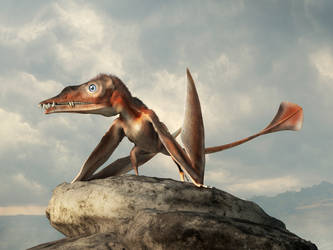ShopDreamUp AI ArtDreamUp
Deviation Actions
Description
In the Helix World there are 3 main orders of the Eudraconia (or "true dragons"), those being the Ignisauriformes ("European" dragons), Wyverniformes (Wyverns) and Hydroserpentiformes (Lungs and knuckers). The 3 genera depicted here are meant to show the more obscure members of each order of dragons.
The Armadrake
Genus Pennatesta
Order Wyverniformes
This small flightless creature is a relative of the Avripean Bluecrest mrcreator3000.deviantart.com/a… and is unusual in a number of ways. One is the similarity of their large "ears" adapted from the same display scales that form it's armour, which are very similar to the ears found on knuckers and even lung, which belong to a completely different order. Another is the fact that it belongs to a group of wyverns known for, amongst other features, their very bird-like obligate bipedal locomotion, yet is practically an obligate quadruped. The armadrake also has very poor eyesight, another feature it doesn't share with the rest of it's relatives. It's sense of smell, however is very well developed, and it uses it's features in order to hunt it's favoured prey of cockatrice and basilisks, both of which are usually avoided by other predators due to their ability to turn any creature to stone by looking them in the eye.
The Hydra
Genus Cephalopteryx
Order Hydroserpentiformes
Now this is a creature so misunderstod in a scientific sense that for over 100 years it was actually classified as an Ignisauriform. Unlike practically all other Hydroseprentiformes, which either have reduced wings or no wings altogether, Hydras have elongated fingers with skin flaps which ressemble heads, used to intimidate predators. the end of the tail is also patterned to resemble a snake and is used as bait to lure prey into an ambush. The hydra's closest relatives amongst Hydroserpentiformes are the gargoyles, which also posess relatively large wings, but unlike the Hydra, Gargoyle's wings more closely resemble a typical dragon's wing, as they are used as gliding apparatus.
The Hookclaw
Genus Pteroambulans
Order Ignisauriformes
This dragon, while not as obscure as the Armadrake of Hydra, still has some unusual traits. For one, it is one of the last lineage of Ignisauriformes which still posess the double-thumbed wing. In the majority of Ignisauriform and Wyverniform lineages, the first digit which equates to the thumb in humans has been lost, so the digit which appears to be the thumb on most dragon's wings is actually the second digit, equal to our index finger. Why this has occurred is unknown, but the Hookclaw is one of very few to still posess this trait. Another unusual trait of this dragon is wing-walking. While this activity is all the rage amongst Wyverniformes, Ignisauriformes never really need to use their wings for ground locomotion due to the possession of four legs specially for terrestrial locomotion. The Hookclaw is perfectly capable of walking on it's fore and hindlegs, but wing walking frees up the forelegs to be used for hunting and manipulation of objects in the environment.
The Armadrake
Genus Pennatesta
Order Wyverniformes
This small flightless creature is a relative of the Avripean Bluecrest mrcreator3000.deviantart.com/a… and is unusual in a number of ways. One is the similarity of their large "ears" adapted from the same display scales that form it's armour, which are very similar to the ears found on knuckers and even lung, which belong to a completely different order. Another is the fact that it belongs to a group of wyverns known for, amongst other features, their very bird-like obligate bipedal locomotion, yet is practically an obligate quadruped. The armadrake also has very poor eyesight, another feature it doesn't share with the rest of it's relatives. It's sense of smell, however is very well developed, and it uses it's features in order to hunt it's favoured prey of cockatrice and basilisks, both of which are usually avoided by other predators due to their ability to turn any creature to stone by looking them in the eye.
The Hydra
Genus Cephalopteryx
Order Hydroserpentiformes
Now this is a creature so misunderstod in a scientific sense that for over 100 years it was actually classified as an Ignisauriform. Unlike practically all other Hydroseprentiformes, which either have reduced wings or no wings altogether, Hydras have elongated fingers with skin flaps which ressemble heads, used to intimidate predators. the end of the tail is also patterned to resemble a snake and is used as bait to lure prey into an ambush. The hydra's closest relatives amongst Hydroserpentiformes are the gargoyles, which also posess relatively large wings, but unlike the Hydra, Gargoyle's wings more closely resemble a typical dragon's wing, as they are used as gliding apparatus.
The Hookclaw
Genus Pteroambulans
Order Ignisauriformes
This dragon, while not as obscure as the Armadrake of Hydra, still has some unusual traits. For one, it is one of the last lineage of Ignisauriformes which still posess the double-thumbed wing. In the majority of Ignisauriform and Wyverniform lineages, the first digit which equates to the thumb in humans has been lost, so the digit which appears to be the thumb on most dragon's wings is actually the second digit, equal to our index finger. Why this has occurred is unknown, but the Hookclaw is one of very few to still posess this trait. Another unusual trait of this dragon is wing-walking. While this activity is all the rage amongst Wyverniformes, Ignisauriformes never really need to use their wings for ground locomotion due to the possession of four legs specially for terrestrial locomotion. The Hookclaw is perfectly capable of walking on it's fore and hindlegs, but wing walking frees up the forelegs to be used for hunting and manipulation of objects in the environment.
Image size
2064x1660px 414.14 KB
© 2015 - 2024 MrCreator3000
Comments0
Join the community to add your comment. Already a deviant? Log In


![[Helix World] - Forest Knucker](https://images-wixmp-ed30a86b8c4ca887773594c2.wixmp.com/f/734b77e9-67e0-4ea3-991f-22e14b5bae08/dcwpfa4-cd1a6005-3419-4e13-a6ec-fc5893078a63.png/v1/crop/w_92,h_92,x_6,y_0,scl_0.075471698113208,q_70,strp/_helix_world____forest_knucker_by_mrcreator3000_dcwpfa4-92s.jpg?token=eyJ0eXAiOiJKV1QiLCJhbGciOiJIUzI1NiJ9.eyJzdWIiOiJ1cm46YXBwOjdlMGQxODg5ODIyNjQzNzNhNWYwZDQxNWVhMGQyNmUwIiwiaXNzIjoidXJuOmFwcDo3ZTBkMTg4OTgyMjY0MzczYTVmMGQ0MTVlYTBkMjZlMCIsIm9iaiI6W1t7ImhlaWdodCI6Ijw9MTAwNyIsInBhdGgiOiJcL2ZcLzczNGI3N2U5LTY3ZTAtNGVhMy05OTFmLTIyZTE0YjViYWUwOFwvZGN3cGZhNC1jZDFhNjAwNS0zNDE5LTRlMTMtYTZlYy1mYzU4OTMwNzhhNjMucG5nIiwid2lkdGgiOiI8PTEyODAifV1dLCJhdWQiOlsidXJuOnNlcnZpY2U6aW1hZ2Uub3BlcmF0aW9ucyJdfQ.mQ-JPQhOKRfVPa9pCZs6D_6pqlPhQZhPtYsoK-5yPJI)

![[Helix World] - Sea Sausages](https://images-wixmp-ed30a86b8c4ca887773594c2.wixmp.com/f/734b77e9-67e0-4ea3-991f-22e14b5bae08/dd05gs7-cd51acfb-add6-4dc0-ac06-454526e75570.png/v1/crop/w_92,h_92,x_0,y_2,scl_0.043809523809524,q_70,strp/_helix_world____sea_sausages_by_mrcreator3000_dd05gs7-92s.jpg?token=eyJ0eXAiOiJKV1QiLCJhbGciOiJIUzI1NiJ9.eyJzdWIiOiJ1cm46YXBwOjdlMGQxODg5ODIyNjQzNzNhNWYwZDQxNWVhMGQyNmUwIiwiaXNzIjoidXJuOmFwcDo3ZTBkMTg4OTgyMjY0MzczYTVmMGQ0MTVlYTBkMjZlMCIsIm9iaiI6W1t7ImhlaWdodCI6Ijw9MTM3MiIsInBhdGgiOiJcL2ZcLzczNGI3N2U5LTY3ZTAtNGVhMy05OTFmLTIyZTE0YjViYWUwOFwvZGQwNWdzNy1jZDUxYWNmYi1hZGQ2LTRkYzAtYWMwNi00NTQ1MjZlNzU1NzAucG5nIiwid2lkdGgiOiI8PTEyODAifV1dLCJhdWQiOlsidXJuOnNlcnZpY2U6aW1hZ2Uub3BlcmF0aW9ucyJdfQ.QC3nR5_bndZxVEwjGF8eBLW8F0iHigyxdbwrCTU6GbM)
![[Very Angry Princess] - Small Animals](https://images-wixmp-ed30a86b8c4ca887773594c2.wixmp.com/f/734b77e9-67e0-4ea3-991f-22e14b5bae08/ddfqii2-ae1f49a8-d6d4-4377-9f08-aa85ba90d1ed.png/v1/crop/w_92,h_92,x_0,y_1,scl_0.081777777777778,q_70,strp/_very_angry_princess____small_animals_by_mrcreator3000_ddfqii2-92s.jpg?token=eyJ0eXAiOiJKV1QiLCJhbGciOiJIUzI1NiJ9.eyJzdWIiOiJ1cm46YXBwOjdlMGQxODg5ODIyNjQzNzNhNWYwZDQxNWVhMGQyNmUwIiwiaXNzIjoidXJuOmFwcDo3ZTBkMTg4OTgyMjY0MzczYTVmMGQ0MTVlYTBkMjZlMCIsIm9iaiI6W1t7ImhlaWdodCI6Ijw9MTE1NiIsInBhdGgiOiJcL2ZcLzczNGI3N2U5LTY3ZTAtNGVhMy05OTFmLTIyZTE0YjViYWUwOFwvZGRmcWlpMi1hZTFmNDlhOC1kNmQ0LTQzNzctOWYwOC1hYTg1YmE5MGQxZWQucG5nIiwid2lkdGgiOiI8PTExMjUifV1dLCJhdWQiOlsidXJuOnNlcnZpY2U6aW1hZ2Uub3BlcmF0aW9ucyJdfQ.Q6csr9k-AslhZMQ55jyS9SyFg89daBEmdMpYMRaAmEM)































